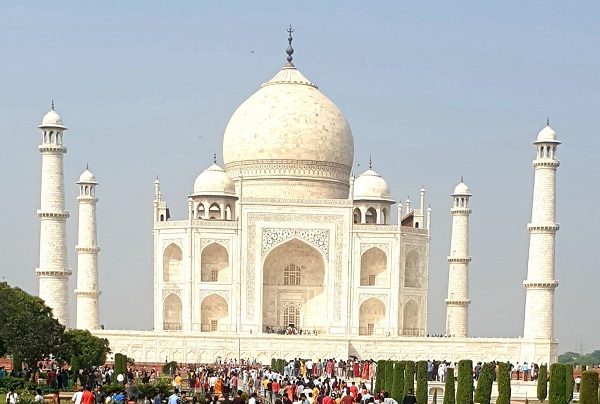Agra, (Samajweekly) Several years after the local bodies submitted detailed status reports to the Supreme Court, the demand for heritage city status still eludes Agra.
The Agra Development Authority (ADA) engaged the Delhi School of Architecture and Town Planning to prepare the report called ‘Vision Document’ for the Taj city, in 2018. �
The apex court had ordered the Uttar Pradesh government to present a vision document on the TTZ, (Taj Trapezium Zone, spread over 10,400 sq km). Delhi’s School of Planning and Architecture was asked to — and drew up — a draft vision document to restore and conserve Agra’s heritage. The Uttar Pradesh Tourism Department and the Agra Divisional Commissioner, who heads the TTZ, supported the demand for declaring Agra a heritage city.
Once again, the local Green activists and conservationists have demanded that the Union government approach UNESCO to secure World Heritage City status for Agra. The Supreme Court has already seized the matter.
Local Heritage Conservation Society activist Mukta Gupta said, “If not Agra, with three World Heritage monuments and dozens of smaller historical buildings, then which other Indian city qualifies for this status? Agra is unique not just architecturally but for its culture, for its history, cuisine and its lifestyle. Mandarins in the Agra Development Authority and a caucus of so-called builders want to destroy the past by snapping the umbilical cords that connect Agra to a glorious past.”
Medieval historians have described Agra as a cosmopolitan city, bigger than London and Paris at the time. “Agra soaks in history. Home to the Taj Mahal, two other Unesco World Heritage sites — the Agra Fort and Fatehpur Sikri — every nook and corner tells a story of its splendid past,” conservationist Rajiv Saxena pointed out.
“A city so rich in culture and architecture, where every street has a historical building, needs to be recognised as a heritage city and the Union ministry should draw up plans to remove encroachments around tourist sites,” says River Connect Campaign activist Rajiv Gupta. The chief reason why tourism has not become “everybody’s business” in Agra and not directly substantially benefited the locals is the lack of heritage consciousness, he added. Even today, the city retains its original names and the functions of various places remain largely the same.
“Yes, in the so-called modern Agra there is evidence of haphazard planning and irrational growth, but then those are not the heritage pieces one would like preserved,” says writer Raj Kishore Raje.
“We have to begin by demarcating the areas as Mughal Agra, British Agra and the Agra Development Authority’s Agra. Only then can one go ahead with conserving the real heritage of the city of the Taj Mahal. And those who think people and their workplaces need to be demolished to make way for modern malls or parking slots are only hurting the spirit of conservation,” local writer Dr N.R. Smith suggests.
The city hasn’t changed much if one takes into account the 1,723 ‘ghazals’ written by Lakshmi Chandra, who describes in great detail the roads and the localities of Agra — from Agra Fort to Charsu Darwaza and beyond to Lashkarpur — which was then the tenting ground for the Mughal army. Were emperor Akbar to rise from his grave in Sikandra someday, he would have no difficulty reaching Agra Fort without asking for directions. “The road plans have not changed, the landmarks are all there,” says social activist Rajan Kishore.
Everytime someone makes a demand to make Agra a heritage city, interest groups and lobbies start opposing the move. If a city with three world heritage monuments and another half a dozen sites waiting to be recognised sooner or later, why can’t the Taj city get this prestigious status, ask the local conservationists. Many scholars and historians rightly wonder which other city in India qualifies for this status, if not Agra.
Apart from the Mughal monuments, Agra with Mathura and Firozabad districts forms the unique religious-cultural entity called the Braj Mandal, the leela-bhoomi of Sri Krishna Radha, who continues to be worshipped by millions of devotees around the world. The Chambal ravines close by and the Bateshwar ghats with 101 Shiva temples in a row along the Yamuna river bank, as also the Jain shrine at Sheoripur are part of the living heritage. Agra is also the headquarter of the Radhasoami faith and the mausoleum to the founder of the sect now ready �after 107 years of continuous construction activity, is looked at as a rival to the Taj Mahal.
The bustling oriental bazaars of Kinari Bazar, Seo ka Bazar, Rawat Para, and the beautifully sculptured havelis, the four ancient Shiva temples at the four corners of the city, the Christian cemeteries and churches, the remnants of the Armenians, not to speak of the four principal industries that are centuries old: the petha making units, the iron foundries, the glassware industries and the leather shoe industry, all collectively constitute Agra’s rich heritage, which for want of promotional efforts continues to remain neglected.
The Urdu Adab owes everything to Agra with the three leading lights — Mirza Ghalib, Mir Taqi Meer and Nazir Akbarabadi — having nurtured the language and ensured its fragrance reaches all shores.
Stones alone do not make heritage. Literature, folklore, traditions, and festivities are all part of the glorious Agra heritage. “The Agra Gharana, the exquisite inlay work, the handicrafts, the carpet weaving, the Zardozi, the poetry of Surdas, the Renuka Dham of Parshuram, the Guru ka Taal gurudwara, the oldest convent school in Asia, of the Congregation of Jesus and Mary established in 1842, the oldest mental hospital, one can go on making a list of so many firsts, and yet we are questioned about our heritage,” laments conservationist Devashish Bhattacharya.









